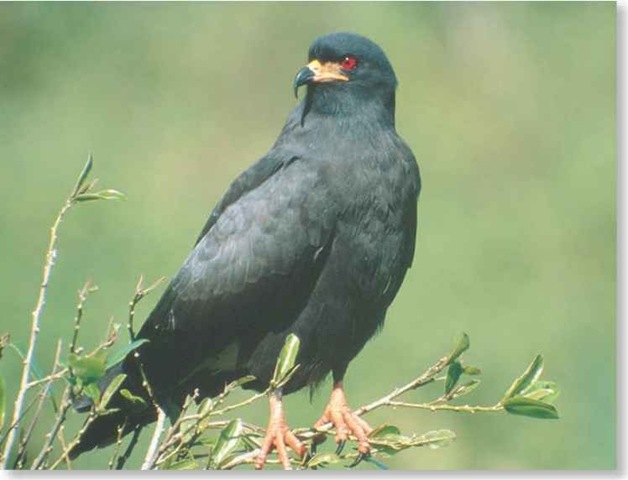ORDER
Falconiformes
FAMILY
Accipitridae
GENUS & SPECIES
key features
• Feeds predominantly on a specific type of snail
• Unlike most raptors, the snail kite socializes with its own species as well as other birds
• One parent may abandon the other and leave it with the fledging chicks; the parent then starts the mating process with a new partner
where in the world!
In the U.S., found only in the Florida Everglades; also the West Indies, and in Central and South America, ranging from Mexico to Argentina

Lifecycle
As its name implies, the snail kite’s life revolves around finding and catching a particular kind of snail — the apple snails in the genus Pomacea.
Habitat
The snail kite’s range is restricted due to the bird’s specialized diet: it eats only Pomacea snails, also known as apple snails. These snails live in marine, freshwater and marshy areas across most of the Western Hemisphere. However; the snail kite is limited to warmer regions with shallow water, where the Pomacea snails come to the surface to breathe; the bird patrols these habitats in search of its prey. To ensure that it will have an adequate food source as well as ample nesting sites, the snail kite makes its home in freshwater canals and marshes;
it seeks out broad expanses of tall grasses dotted with clumps of small trees and bushes, with an occasional island of larger trees.
Grassy grip snail kites prefer areas with tall grasses.
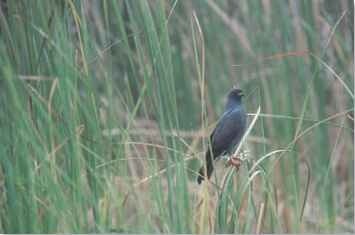
conservation
Although snail kite numbers throughout most of its range have remained relatively stable, the Florida Everglades populations have suffered greatly due to drainage and flood control. The bird is on the endangered species list for the Everglades and numbers only about 500. The U.S. Fish and Wildlife Service has instituted a Snail Kite Recovery Program, which includes annual surveys.
Breeding
During courtship, snail kites fly to altitudes of up to 3,000′ and then repeatedly dive in sudden short dips, wings folded, greeting each other with their harsh cries, kor-ee-ee-a, kor-ee-ee-a. Once a pair has formed, the two birds work together to build a nest. The nest is a carelessly built, flat structure of sticks about 1′ in diameter and 3-1 5′ above the water level, built either on dense marsh grass or bushes growing in the water: The female lays 3-4 dull-white eggs with brown blotches; both sexes share incubation for a total of about 30 days. The hatchlings are covered in buff down. In some kite nests, especially when food is plentiful, one parent abandons the young right before fledging; female snail kites are just as likely to leave as males. While the remaining parent continues to provide for the brood until it reachs independence, about a month later, the deserting bird is free to begin the breeding cycle again with a new partner. When food is scarce, neither parent deserts the nest, and both will struggle together to raise the hungry chicks.
Food & hunting
One of the most specialized feeders, the snail kite catches and shells large numbers of apple snails. In Venezuela it occasionally eats crabs (below). When hunting, the kite sits on a high perch or soars through the air, 5-30′ above the water and marsh grass, with its long, curved bill pointed downward, watching for snails. After snatching a snail from the surface, the kite brings it back to its perch and uses its long, curved bill to dig beneath the hard outer cover of the snail. Next, it cuts the spinal muscle, which holds the snail in its shell, and finally removes the snail and swallows it whole or rips it into pieces. Capturing and learning how to remove the snail from its shell takes practice, and juveniles go through a great deal of trial and error (and presumably hunger) before finally mastering the process after a few weeks.

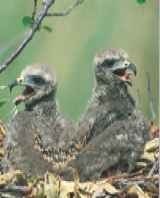
A More snails, please! Hungry hatchlings cry for food as they impatiently wait for their parents’ return.
Even when researchers in the Everglades could not find snails with man-made equipment, such as bottom samplers that sift through mud and sand, the snail kites were able to find them with ease.
On warm days, it takes the kite just seconds to find a snail, but on cool days, when they come to the surface less frequently, it may take 20 minutes.
escargot escapade
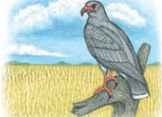
Scanning…
The snail kite scans large areas of marsh for its prey by stationing itself on a perch or slowly gliding through the air.
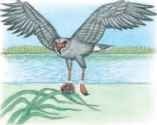
Grabbing…
Once a snail is spotted, the kite swoops down to the water’s surface and reaches with its long legs and claws to grab the snail.
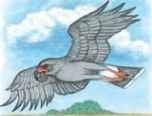
Passing…
The kite then returns to its perch, passing the apple snail up to its beak so it won’t risk losing its meal while landing.
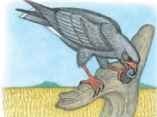
Eating
Once back on its perch, the kite uses one foot to secure the snail’s shell and its long, curved beak to remove the snail.
Behavior
The snail kite’s behavior is as unique as its diet; it is highly influenced by the availability of apple snails. Most members of the Accipitridae family are solitary, but the snail kite is quite social. The extremely gregarious snail kites nest in colonies and are very tolerant, not only of their own kind but of other species of bird as well, especially the limpkin and boat-tailed grackle, both of which also eat apple snails. Although the snail kites will usually tolerate outsiders, there are times when they are defensive. If an exceptionally large number of apple snails shows up in the territory of one colony, the birds will aggressively chase away other birds, including other snail kites.
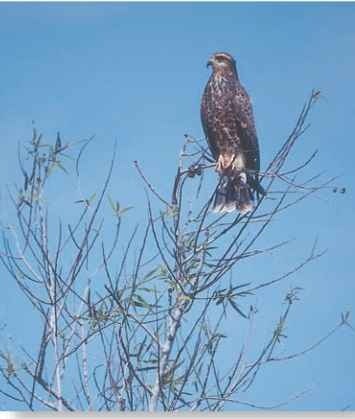
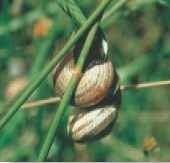
A Female lookout A snail kite perches on a small branch and searches for snails.
Sought-after snail The social kite shares its supply of apple snails (left) with other birds.
PROFILE
Snail Kite
One of the most specialized feeders, the snail kite has a beak and claws designed for tearing snails loose from their shells.
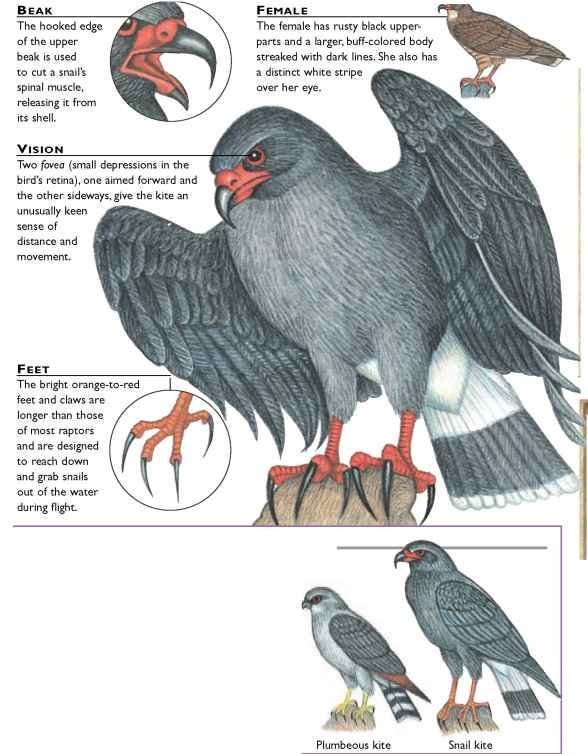
Creature comparisons
At 13-15″, the plumbeous kite (Ictinia plumbea) is smaller than the snail kite. The plumbeous kite is ash gray with slate-black wings and mantle, and a white spotted tail, much lighter than its snail-eating relative. Ranging from east-central Mexico to northern Argentina and Paraguay, the plumbeous kite feeds primarily on insects, which it is able to snatch out of the air with its claws. It sometimes takes small snakes, lizards and frogs, a much broader menu than the snail kite’s.
| VITAL | ||
| STATISTICS | ||
| Weight | 12-21 oz. | |
| Length | 16-19″ | |
| Wingspan | 41-46″ | |
| Sexual Maturity | About 10 months | |
| Breeding Season | February-July varies with ‘ region | |
| Number of Eggs | 2-4 | |
| Incubation 26-30 days Period | ||
| Fledging Period | 40-49 days | |
| Breeding Interval | Up to 3 clutches per | |
| season | ||
| Typical Diet | Snails of the genus Pomacea | |
| Lifespan | Unknown | |
RELATED SPECIES
• The snail kite is 1 of 2 species in the genus Rostrhamus; the other is the slender-billed kite, R. hamatus, which is quite different from the snail kite. These two kites are among over 200 species in the family Accipitridae, which consists primarily of hawks, eagles and kites, including the zone-tailed hawk, Buteo albo-notatus. These birds join falcons and osprey in the order Falconiformes.
